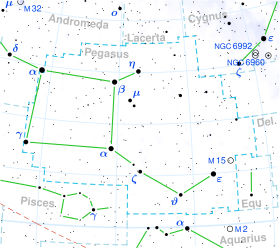Binary star system in the constellation Pegasus
Psi Pegasi
Observation dataEpoch J2000 Equinox J2000
Constellation
Pegasus
Right ascension
23 57 45.52681
Declination
25° 08′ 29.0480″
Apparent magnitude (V)
4.66
Characteristics
Spectral type
M3III
U−B color index
+1.66
B−V color index
+1.59
Variable type
suspected
Astrometry Radial velocity (Rv )−6.59±0.23 km/s Proper motion (μ) RA: −35.24 mas /yr Dec.: −31.60 mas /yr Parallax (π)6.85 ± 0.24 mas Distance 480 ± 20 ly pc ) Absolute magnitude (MV )–1.19 Orbit Period (P)55.06±11.31 yr Semi-major axis (a)0.170±0.016″ Eccentricity (e)0.19±0.10 Inclination (i)65.6±2.2° Longitude of the node (Ω)46.6±2.3° Periastron epoch (T)2,001.83±8.81 Argument of periastron (ω)159.7±11.9° Details Radius 98±6 R ☉ Luminosity 960 L ☉ Temperature 3,882 K Other designations ψ Peg , 84 Pegasi , NSV 14777, BD +24°4865, FK5 1629, GC 33230, HD 224427, HIP 118131, HR 9064, SAO 91611, WDS J23578+2508AB Database references SIMBAD data
Psi Pegasi , which is Latinized from ψ Pegasi, is a binary star system within the great square in the northern constellation of Pegasus . It has a red hue and is faintly visible to the naked eye with an apparent visual magnitude of 4.66. This object is located at a distance of approximately 476 light-years away from the Sun based on parallax , but is drifting closer with a radial velocity of −6.6 km/s.
A visual band light curve for Psi Pegasi, plotted from data published by Tabur et al. (2009) The orbital elements for this system were computed for the first time in 2004 based on interferometric observations, yielding an orbital period of roughly 55 years and an eccentricity of about 0.19. The visible component is an aging red giant star on the asymptotic giant branch with a stellar classification of M3III. It is a suspected variable, probably semiregular , with its magnitude varying from 4.63 to 4.69 over periods of 37.4 and 118.9 days. With the supply of hydrogen exhausted at its core , the star has cooled and expanded to around 98 times the Sun's radius . It is radiating 960 times the luminosity of the Sun from its bloated photosphere at an effective temperature of 3,882 K .
References
^ Van Leeuwen, F. (2007). "Validation of the new Hipparcos reduction". Astronomy and Astrophysics . 474 (2): 653–664. arXiv :0708.1752 . Bibcode :2007A&A...474..653V . doi :10.1051/0004-6361:20078357 . S2CID 18759600 . Vizier catalog entry
^ Ducati, J. R. (2002). "VizieR Online Data Catalog: Catalogue of Stellar Photometry in Johnson's 11-color system". CDS/ADC Collection of Electronic Catalogues . 2237 . Bibcode :2002yCat.2237....0D .
^ Keenan, Philip C.; McNeil, Raymond C. (1989), "The Perkins catalog of revised MK types for the cooler stars", Astrophysical Journal Supplement Series , 71 : 245, Bibcode :1989ApJS...71..245K , doi :10.1086/191373 , S2CID 123149047 .
^ Samus, N. N.; Durlevich, O. V.; et al. (2009). "VizieR Online Data Catalog: General Catalogue of Variable Stars (Samus+ 2007-2013)". VizieR On-line Data Catalog: B/GCVS. Originally Published in: 2009yCat....102025S . 1 . Bibcode :2009yCat....102025S .
^ Famaey, B.; et al. (2005). "Local kinematics of K and M giants from CORAVEL/Hipparcos/Tycho-2 data". Astronomy & Astrophysics . 430 : 165–186. arXiv :astro-ph/0409579 . Bibcode :2005A&A...430..165F . doi :10.1051/0004-6361:20041272 . S2CID 17804304 .
^ Anderson, E.; Francis, Ch. (2012). "XHIP: An extended hipparcos compilation". Astronomy Letters . 38 (5): 331. arXiv :1108.4971 . Bibcode :2012AstL...38..331A . doi :10.1134/S1063773712050015 . S2CID 119257644 . Vizier catalog entry
^ Olevic, D.; Cvetkovic, Z. (2004). "Orbits of 6 Binaries" . Serbian Astronomical Journal . 168 (168): 25. Bibcode :2004SerAJ.168...25O . doi :10.2298/SAJ0468025O .
^ Arroyo-Torres, B.; et al. (June 2014), "VLTI/AMBER observations of cold giant stars: atmospheric structures and fundamental parameters", Astronomy & Astrophysics , 566 : 11, arXiv :1404.7384 , Bibcode :2014A&A...566A..88A , doi :10.1051/0004-6361/201323264 , S2CID 16778588 , A88.
^ Martínez, M. Isabel Pérez; et al. (2011). "The basal chromospheric Mg ii h+k flux of evolved stars: Probing the energy dissipation of giant chromospheres" . Monthly Notices of the Royal Astronomical Society . 414 (1): 418. arXiv :1102.4832 . Bibcode :2011MNRAS.414..418P . doi :10.1111/j.1365-2966.2011.18421.x . S2CID 59268230 . Vizier catalog entry
"psi Peg" . SIMBAD Centre de données astronomiques de Strasbourg . Retrieved 2019-10-26.Harrington, Philip S. (2010). Cosmic Challenge: The Ultimate Observing List for Amateurs ISBN 9781139493680
^ Tabur, V.; Bedding, T. R.; Kiss, L. L.; Moon, T. T.; Szeidl, B.; Kjeldsen, H. (December 2009). "Long-term photometry and periods for 261 nearby pulsating M giants" . Monthly Notices of the Royal Astronomical Society 400 (4): 1945–1961. arXiv :0908.3228 . Bibcode :2009MNRAS.400.1945T . doi :10.1111/j.1365-2966.2009.15588.x . S2CID 15358380 .
Malkov, O. Yu.; Tamazian, V. S.; Docobo, J. A.; Chulkov, D. A. (2012). "Dynamical masses of a selected sample of orbital binaries" . Astronomy & Astrophysics . 546 : A69. Bibcode :2012A&A...546A..69M . doi :10.1051/0004-6361/201219774 . Vizier catalog entry
Mason, Brian D.; et al. (2001). "The 2001 US Naval Observatory Double Star CD-ROM. I. The Washington Double Star Catalog" . The Astronomical Journal . 122 (6): 3466. Bibcode :2001AJ....122.3466M . doi :10.1086/323920 . Vizier catalog entry
Eggen, Olin J. (July 1992), "Asymptotic giant branch stars near the sun", Astronomical Journal , 104 (1): 275–313, Bibcode :1992AJ....104..275E , doi :10.1086/116239 .
Watson, C. L. (2006). "The International Variable Star Index (VSX)". The Society for Astronomical Sciences 25th Annual Symposium on Telescope Science. Held May 23–25 . 25 : 47. Bibcode :2006SASS...25...47W .
Categories :
Text is available under the Creative Commons Attribution-ShareAlike License. Additional terms may apply.
**DISCLAIMER** We are not affiliated with Wikipedia, and Cloudflare.
The information presented on this site is for general informational purposes only and does not constitute medical advice.
You should always have a personal consultation with a healthcare professional before making changes to your diet, medication, or exercise routine.
AI helps with the correspondence in our chat.
We participate in an affiliate program. If you buy something through a link, we may earn a commission 💕
↑

